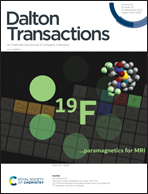A new family of luminescent [Pt(pbt)2(C6F5)L]n+ (n = 1, 0) complexes: synthesis, optical and cytotoxic studies†
Abstract
Given the widely recognized bioactivity of 2-arylbenzothiazoles against tumor cells, we have designed a new family of luminescent heteroleptic pentafluorophenyl-bis(2-phenylbenzothiazolyl) PtIV derivatives, fac-[Pt(pbt)2(C6F5)L]n+ (n = 1, 0) [L = 4-Mepy 1, 4-pyridylbenzothiazole (pybt) 2, 4,4′-bipyridine (4,4′-bpy) 3, 1,2-bis-(4-pyridyl)ethylene (bpe) 4 (E/Z ratio: 90/10), 1,4-bis-(pyridyl)butadiyne (bpyb) 5, trifluoroacetate (−OCOCF3) 6] and a dinuclear complex [{Pt(pbt)2(C6F5)}2(μ-bpyb)](PF6)27, in which the trans ligand to the metalated C-(pbt) was varied to modify the optical properties and lipophilicity. Their photophysical properties were systematically studied through experimental and theoretical investigations, which were strongly dependent on the identity of the N-bonded ligand. Thus, complexes 1, 3 and 6 display, in different media, emission from the triplet excited states of primarily intraligand 3ILCT nature localized on the pbt ligand, while the emissions of 2, 5 and 7 were ascribed to a mixture of close 3IL′(N donor)/3ILCT(pbt) excited states, as supported by lifetime measurements and theoretical calculations. Irradiation of the initial E/Z mixture of 4 (15 min) led to a steady state composed of roughly 1 : 1.15 (E : Z) and this complex was not emissive at room temperature due to an enhanced intramolecular E to Z isomerization process of the 1,2-bis-(4-pyridyl)ethylene ligand. Complexes 1–3 and 6 showed excellent quantum yields for the generation of singlet oxygen in aerated MeCN solution with the values of ϕ(1O2) ranging from 0.66 to 0.86 using phenalenone as a reference. Cationic complexes 1–3 exhibited remarkable efficacy in the nanomolar range against A549 (lung carcinoma) and HeLa (cervix carcinoma) cell lines with notable selectivity relative to the non-tumorigenic BEAS-2B (bronchial epithelium) cells. In the A549 cell line, the neutral complex 6 showed low cytotoxicity (IC50: 29.40 μM) and high photocytotoxicity (IC50: 5.75) when cells were irradiated with blue light for 15 min. These complexes do not show evidence of DNA interaction.
![Graphical abstract: A new family of luminescent [Pt(pbt)2(C6F5)L]n+ (n = 1, 0) complexes: synthesis, optical and cytotoxic studies](/en/Image/Get?imageInfo.ImageType=GA&imageInfo.ImageIdentifier.ManuscriptID=D3DT01759A&imageInfo.ImageIdentifier.Year=2023)


 Please wait while we load your content...
Please wait while we load your content...